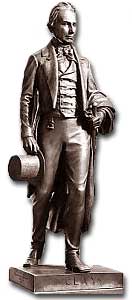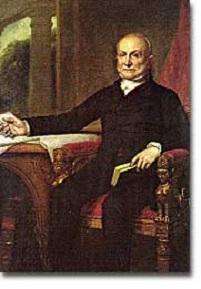23d. The 1824 Election and the "Corrupt Bargain"

Henry Clay was thrice a candidate for the Presidency and the chief architect of the Compromise of 1850 which moved slavery to the forefront of Congressional debates.
The 1824 presidential election marked the final collapse of the Republican-Federalist political framework. For the first time no candidate ran as a Federalist, while five significant candidates competed as Democratic-Republicans. Clearly, no party system functioned in 1824. The official candidate of the Democratic-Republicans to replace Monroe was William H. Crawford, the secretary of the treasury. A caucus of Republicans in Congress had selected him, but this backing by party insiders turned out to be a liability as other candidates called for a more open process for selecting candidates.
The outcome of the very close election surprised political leaders. The winner in the all-important Electoral College was Andrew Jackson, the hero of the War of 1812, with ninety-nine votes. He was followed by John Quincy Adams, the son of the second president and Monroe's secretary of state, who secured eighty-four votes. Meanwhile Crawford trailed well behind with just forty-one votes. Although Jackson seemed to have won a narrow victory, receiving 43 percent of the popular vote versus just 30 percent for Adams, he would not be seated as the country's sixth president. Because nobody had received a majority of votes in the electoral college, the House of Representatives had to choose between the top two candidates.

After losing the Presidency to Andrew Jackson in 1828, John Quincy Adams was elected to the House of Representatives where he served until his death in 1848.
Henry Clay, the speaker of the House of Representatives, now held a decisive position. As a presidential candidate himself in 1824 (he finished fourth in the electoral college), Clay had led some of the strongest attacks against Jackson. Rather than see the nation's top office go to a man he detested, the Kentuckian Clay forged an Ohio Valley-New England coalition that secured the White House for John Quincy Adams. In return Adams named Clay as his secretary of state, a position that had been the stepping-stone to the presidency for the previous four executives.
This arrangement, however, hardly proved beneficial for either Adams or Clay. Denounced immediately as a "corrupt bargain" by supporters of Jackson, the antagonistic presidential race of 1828 began practically before Adams even took office. To Jacksonians the Adams-Clay alliance symbolized a corrupt system where elite insiders pursued their own interests without heeding the will of the people.
The Jacksonians, of course, overstated their case; after all, Jackson fell far short of a majority in the general vote in 1824. Nevertheless, when the Adams administration continued to favor a strong federal role in economic development, Jacksonians denounced their political enemies as using government favors to reward their friends and economic elites. By contrast, Jackson presented himself as a champion of the common man and by doing so furthered the democratization of American politics.






